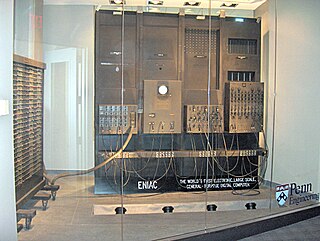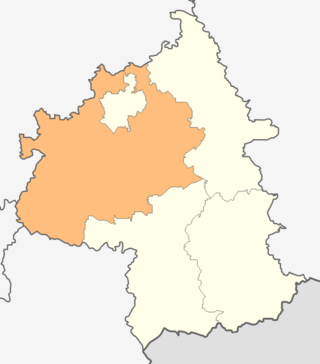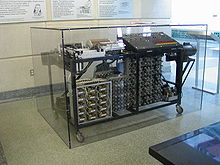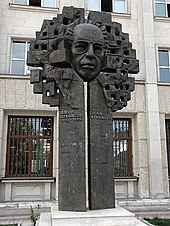
The Atanasoff–Berry computer (ABC) was the first automatic electronic digital computer. Limited by the technology of the day, and execution, the device has remained somewhat obscure. The ABC's priority is debated among historians of computer technology, because it was neither programmable, nor Turing-complete. Conventionally, the ABC would be considered the first electronic ALU – which is integrated into every modern processor's design.

ENIAC was the first programmable, electronic, general-purpose digital computer, completed in 1945. Other computers had some of these features, but ENIAC was the first to have them all. It was Turing-complete and able to solve "a large class of numerical problems" through reprogramming.

John Adam Presper Eckert Jr. was an American electrical engineer and computer pioneer. With John Mauchly, he designed the first general-purpose electronic digital computer (ENIAC), presented the first course in computing topics, founded the Eckert–Mauchly Computer Corporation, and designed the first commercial computer in the U.S., the UNIVAC, which incorporated Eckert's invention of the mercury delay-line memory.

Engineering Research Associates, commonly known as ERA, was a pioneering computer firm from the 1950s. ERA became famous for their numerical computers, but as the market expanded they became better known for their drum memory systems. They were eventually purchased by Remington Rand and merged into their UNIVAC department. Many of the company founders later left to form Control Data Corporation.

John William Mauchly was an American physicist who, along with J. Presper Eckert, designed ENIAC, the first general-purpose electronic digital computer, as well as EDVAC, BINAC and UNIVAC I, the first commercial computer made in the United States.

Sperry Corporation was a major American equipment and electronics company whose existence spanned more than seven decades of the 20th century. Sperry ceased to exist in 1986 following a prolonged hostile takeover bid engineered by Burroughs Corporation, which merged the combined operation under the new name Unisys. Some of Sperry's former divisions became part of Honeywell, Lockheed Martin, Raytheon Technologies, and Northrop Grumman.

The UNIVAC I was the first general-purpose electronic digital computer design for business application produced in the United States. It was designed principally by J. Presper Eckert and John Mauchly, the inventors of the ENIAC. Design work was started by their company, Eckert–Mauchly Computer Corporation (EMCC), and was completed after the company had been acquired by Remington Rand. In the years before successor models of the UNIVAC I appeared, the machine was simply known as "the UNIVAC".

UNIVAC was a line of electronic digital stored-program computers starting with the products of the Eckert–Mauchly Computer Corporation. Later the name was applied to a division of the Remington Rand company and successor organizations.

Herman Heine Goldstine was a mathematician and computer scientist, who worked as the director of the IAS machine at the Institute for Advanced Study and helped to develop ENIAC, the first of the modern electronic digital computers. He subsequently worked for many years at IBM as an IBM Fellow, the company's most prestigious technical position.
Clark R. Mollenhoff was a Pulitzer Prize winning American journalist, an attorney who served as Presidential Special Counsel, and a columnist for The Des Moines Register.
The Eckert–Mauchly Computer Corporation (EMCC) was a computer company founded by J. Presper Eckert and John Mauchly. It was incorporated on December 22, 1947. After building the ENIAC at the University of Pennsylvania, Eckert and Mauchly formed EMCC to build new computer designs for commercial and military applications. The company was initially called the Electronic Control Company, changing its name to Eckert–Mauchly Computer Corporation when it was incorporated. In 1950, the company was sold to Remington Rand, which later merged with Sperry Corporation to become Sperry Rand, and survives today as Unisys.
Honeywell, Inc. v. Sperry Rand Corp., et al., 180 U.S.P.Q. 673, was a landmark U.S. federal court case that in October 1973 invalidated the 1964 patent for the ENIAC, the world's first general-purpose electronic digital computer. The decision held, in part, the following: 1. that the ENIAC inventors had derived the subject matter of the electronic digital computer from the Atanasoff–Berry computer (ABC), prototyped in 1939 by John Atanasoff and Clifford Berry, 2. that Atanasoff should have legal recognition as the inventor of the first electronic digital computer and 3. that the invention of the electronic digital computer ought to be placed in the public domain.
Theory and Techniques for Design of Electronic Digital Computers was a course in the construction of electronic digital computers held at the University of Pennsylvania's Moore School of Electrical Engineering between July 8, 1946, and August 30, 1946, and was the first time any computer topics had ever been taught to an assemblage of people. The course disseminated the ideas developed for the EDVAC and initiated an explosion of computer construction activity in the United States and internationally, especially in the United Kingdom.

Arthur Walter Burks was an American mathematician who worked in the 1940s as a senior engineer on the project that contributed to the design of the ENIAC, the first general-purpose electronic digital computer. Decades later, Burks and his wife Alice Burks outlined their case for the subject matter of the ENIAC having been derived from John Vincent Atanasoff. Burks was also for several decades a faculty member at the University of Michigan in Ann Arbor.

Alice Burks was an American author of children's books and books about the history of electronic computers.
Boyadzhik is a village in Tundzha Municipality of Yambol Province, Bulgaria. Situated 22 km west of the city of Yambol, and 8 km southwest of the Bulgarian Air Force's Bezmer Air Base, at an elevation 153 m. Population 1,514. It is the birthplace of Ivan Atanasov, the father of John Vincent Atanasoff.

Tundzha Municipality is a municipality of Yambol Province, southeastern Bulgaria. The municipality has an area of 1,218.86 square kilometres, making it the second-largest by area in the country after the Capital Municipality. It covers 44 villages and has a population of 21,435 according to 2005 data. All the villages in the province are administratively equal, and the administrative centre of the municipality is located in the provincial capital of Yambol, which is not part of Tundzha municipality itself: the city is equivalent to Yambol Municipality, which is an enclave within Tundzha Municipality. Tundzha municipality is named after the Tundzha River, the most significant tributary of the Maritsa.
Earl Richard Larson was a United States district judge of the United States District Court for the District of Minnesota.

The Man Who Invented the Computer is a 2010 historical biography by author Jane Smiley about American physicist John Vincent Atanasoff and the invention of the computer. The book follows Atanasoff as he collaborates with others to develop the 1942 Atanasoff–Berry Computer (ABC), the first electronic digital computing device.
The Boyadzhik massacre was the massacre of 145 Bulgarian civilians committed by irregular Ottoman troops in the Bulgarian village of Boyadzhik on and after 24 May [O.S. 11 May] 1876.














